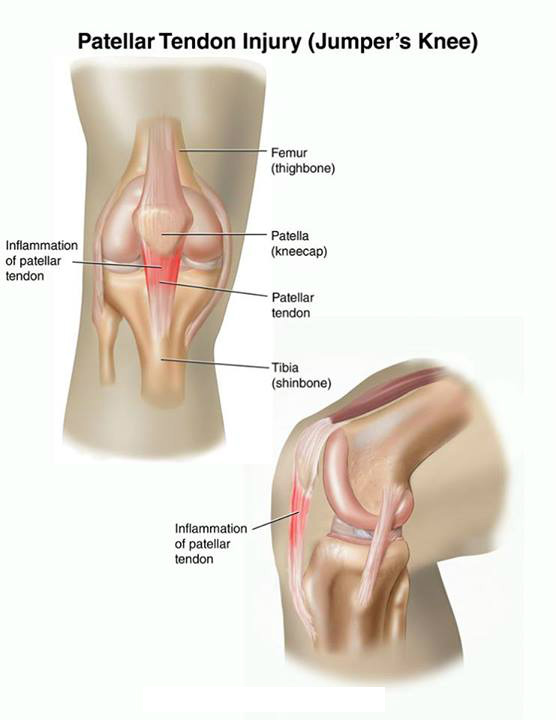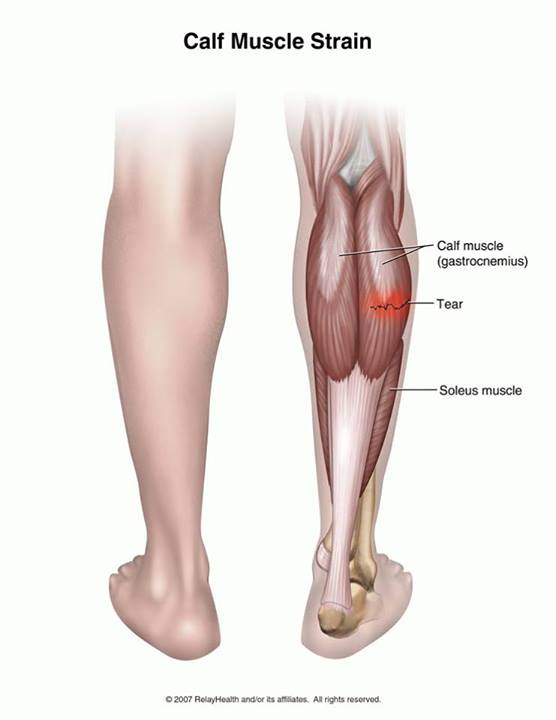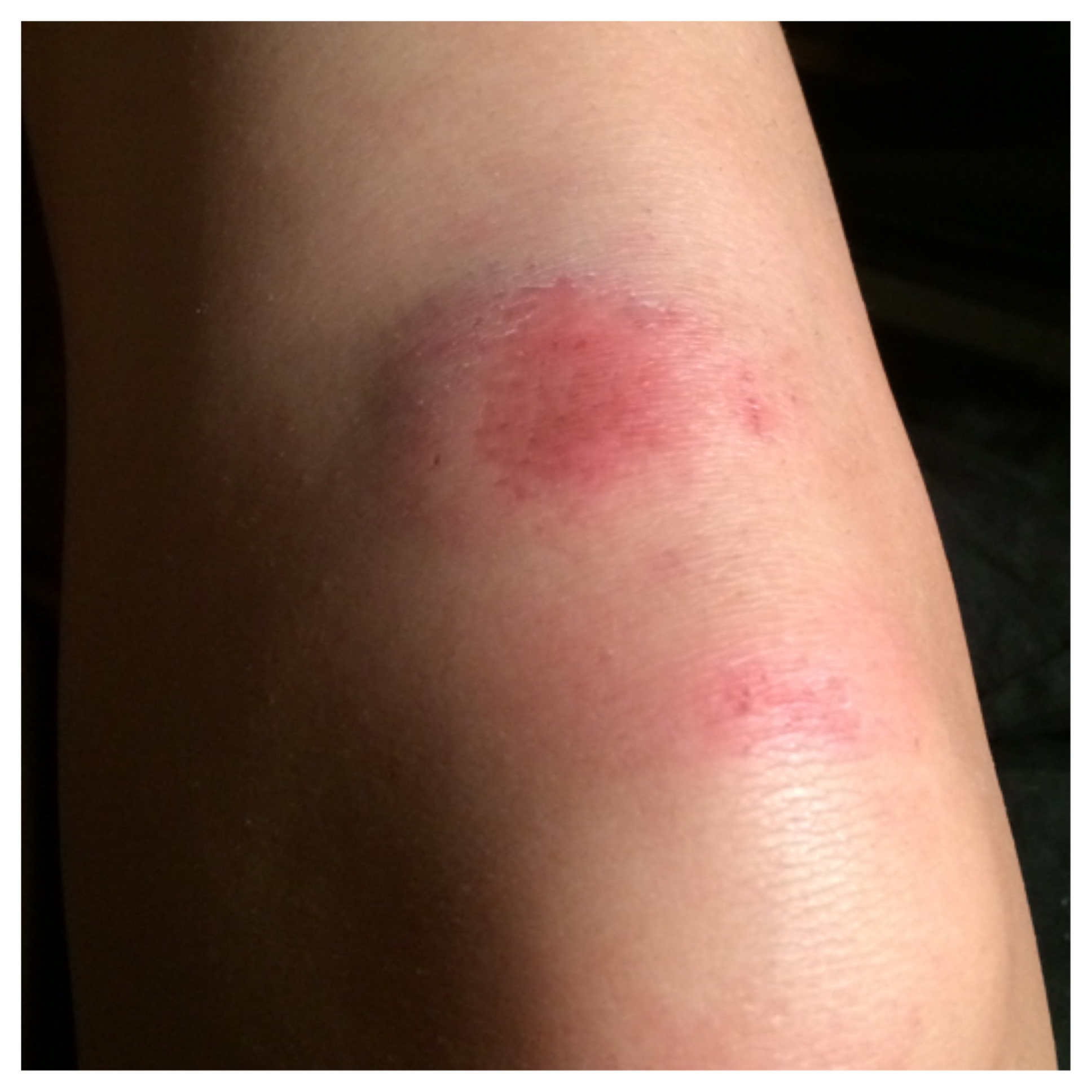Jumpers knee

What is jumper’s knee?
Jumper’s knee is inflammation or micro-tears in the tendon that connects the kneecap (patella) to the shinbone. It is also called patellar tendinopathy.
Tendons, are strong bands of connective tissue that attach muscle to bone. When a tendon is acutely injured it is called a strain. Tendonitis is when a tendon is inflamed. When there are micro-tears in a tendon from repeated injury it is called tendinosis. Tendinopathy is the term for both inflammation and micro-tears.
How does it occur?
Activities that put repeated stress on the patellar tendon can cause it to be inflamed. Too much jumping is the most common cause. Other repeated activities such as running, walking, or bicycling may also cause the problem.
Jumper’s knee can also happen if your hips, legs, knees, or feet are not aligned properly. People whose hips are wide, who are knock-kneed, or who have feet with arches that collapse when they walk or run can have this problem.
The patellar tendon may sometimes rupture or tear completely during strenuous activity.
symptoms of jumper’s knee?
Symptoms may include:
- Pain and tenderness around the patellar tendon.
- Swelling in your knee joint or swelling where the patellar tendon attaches to
- the shinbone.
- Pain with jumping, running, or walking, especially downhill or downstairs
- Pain when you bend or straighten the leg
- Tenderness behind the kneecap
- If your patellar tendon is ruptured, usually you will have sudden severe pain and you will not be able to straighten your leg or walk.
Diagnosis of jumper’s knee?
Your healthcare provider will examine your knee. He or she will also have you run, jump, or squat to see if this causes pain. Your feet will be examined to see if you have a problem with over-pronation. You may have X-rays or an MRI of your knee.
Treatement of jumper’s knee?
To treat this condition:
Put an ice pack, gel pack, or package of frozen vegetables, wrapped in a cloth on the area every 3 to 4 hours, for up to 20 minutes at a time.
Elevate your knee on a pillow when you sit or lie down.
Take an anti-inflammatory medicine such as ibuprofen, or other medicine as directed by your provider. Nonsteroidal anti-inflammatory medicines (NSAIDs) may cause stomach bleeding and other problems. These risks increase with age. Read the label and take as directed. Unless recommended by your healthcare provider, do not take for more than 10 days.
Follow your provider’s instructions for doing exercises to help you recover. Your healthcare provider will show you exercises to help decrease the pain behind your kneecap.
Your healthcare provider may suggest that you:
Wear shoe inserts (called orthotics) for over-pronation. You can buy orthotics at a pharmacy or athletic shoe store or they can be custom-made.
Use an infrapatellar strap, a strap placed beneath the kneecap over the patellar tendon.
Wear a neoprene knee sleeve, which supports your knee and patella.
While you recover from your injury, you will need to change your sport or activity to one that does not make your condition worse. For example, bicycle or swim instead of run.
In severe cases, you may need surgery.
How long will the effects it last?
A tendon that is only mildly inflamed and has just started to hurt may improve within a few weeks. A tendon that is significantly inflamed and has been painful for a long time may take up to a few months to improve. You need to stop doing the activities that cause pain until your tendon has healed. If you continue doing activities that cause pain, your symptoms will return and it will take longer to recover.
When can I return to my normal activities?
Everyone recovers from an injury at a different rate. Return to your activities depends on how soon your knee recovers, not by how many days or weeks it has been since your injury has occurred. In general, the longer you have symptoms before you start treatment, the longer it will take to get better. The goal is to return to your normal activities as soon as is safely possible. If you return too soon you may worsen your injury.
You may safely return to your normal activities when, starting from the top of the list and progressing to the end, each of the following is true:
You can straighten and bend your injured knee without pain
Your knee and leg are as strong as your uninjured knee and leg
Your knee is not swollen
You are able bend, walk, and squat without pain
How can I prevent jumper’s knee?
Jumper’s knee can best be prevented by having strong thigh muscles. It also helps to stretch before and after exercising, and wear shoes that fit properly and are right for the activity.
Rehabilitation
Jumper’s Knee Exercises

You can do the first 4 exercises right away. When you have less pain in your knee, you can do the remaining exercises.
Standing hamstring stretch:
Put the heel of the leg on your injured side on a stool about 15 inches high. Keep your leg straight. Lean forward, bending at the hips, until you feel a mild stretch in the back of your thigh. Make sure you don’t roll your shoulders or bend at the waist when doing this or you will stretch your lower back instead of your leg. Hold the stretch for 15 to 30 seconds. Repeat 3 times.
Quadriceps stretch:
Stand an arm’s length away from the wall with your injured side farthest from the wall. Facing straight ahead, brace yourself by keeping one hand against the wall. With your other hand, grasp the ankle on your injured side and pull your heel toward your buttocks. Don’t arch or twist your back. Keep your knees together.
Hold this stretch for 15 to 30 seconds.
Side-lying leg lift:
Lie on your uninjured side. Tighten the front thigh muscles on your injured leg and lift that leg 8 to 10 inches away from the other leg. Keep the leg straight and lower it slowly. Do 2 sets of 15.
Straight leg raise:
Lie on your back with your legs straight out in front of you. Bend the knee on your uninjured side and place the foot flat on the floor. Tighten the thigh muscle on your injured side and lift your leg about 8 inches off the floor. Keep your leg straight and your thigh muscle tight. Slowly lower your leg back down to the floor. Do 2 sets of 15.
Prone hip extension:
Lie on your stomach with your legs straight out behind you. Draw your belly button in towards your spine and tighten your abdominal muscles. Tighten the buttocks and thigh muscles of the leg on your injured side and lift the leg off the floor about 8 inches. Keep your leg straight. Hold for 5 seconds. Then lower your leg and relax. Do 2 sets of 15.
Clam exercise:
Lie on your uninjured side with your hips and knees bent and feet together. Slowly raise your top leg toward the ceiling while keeping your heels touching each other. Hold for 2 seconds and lower slowly. Do 2 sets of 15 repetitions.
Step-up:
Stand with the foot of your injured leg on a support 3 to 5 inches high (like a small step or block of wood). Keep your other foot flat on the floor. Shift your weight onto the injured leg on the support. Straighten your injured leg as the other leg comes off the floor. Return to the starting position by bending your injured leg and slowly lowering your uninjured leg back to the floor. Do 2 sets of 15.
Wall squat with a ball:
Stand with your back, shoulders, and head against a wall. Look straight ahead. Keep your shoulders relaxed and your feet 3 feet from the wall and shoulder’s width apart. Place a soccer or basketball-sized ball behind your back. Keeping your back against the wall, slowly squat down to a 45-degree angle. Your thighs will not yet be parallel to the floor. Hold this position for 10 seconds and then slowly slide back up the wall. Repeat 10 times. Build up to 2 sets of 15.
Jumper’s Knee Exercises

Knee stabilization:
Wrap a piece of elastic tubing around the ankle of your uninjured leg. Tie a knot in the other end of the tubing and close it in a door at about ankle height.
Stand facing the door on the leg without tubing and bend your knee slightly, keeping your thigh muscles tight. Stay in this position while you move the leg with the tubing straight back behind you. Do 2 sets of 15.
Turn 90 degrees so the leg without tubing is closest to the door. Move the leg with tubing away from your body. Do 2 sets of 15.
Turn 90 degrees again so your back is to the door. Move the leg with tubing straight out in front of you. Do 2 sets of 15.
Turn your body 90 degrees again so the leg with tubing is closest to the door. Move the leg with tubing across your body. Do 2 sets of 15.
Hold onto a chair if you need help balancing. This exercise can be made more challenging by standing on a firm pillow or foam mat while you move the leg with tubing.
Resisted terminal knee extension:
Make a loop with a piece of elastic tubing by tying a knot in both ends. Close the knot in a door at knee height. Step into the loop with your injured leg so the tubing is around the back of your knee. Lift the other foot off the ground and hold onto a chair for balance, if needed. Bend the knee with tubing about 45 degrees. Slowly straighten your leg, keeping your thigh muscle tight as you do this. Repeat 15 times. Do 2 sets of 15. If you need an easier way to do this, stand on both legs for better support while you do the exercise.
Decline eccentric squat:
Stand with both feet on an angled platform or with your heels on a 3-inch-high board. Put all of your weight on your injured leg and squat down to a 45-degree angle. Use your other leg to help you return to a standing position from the squat. You should lower your body to a squat using only your injured leg but you can use both legs to return to standing. When this exercise gets easy, hold weights in your hands to make the exercise more difficult. Do 2 sets of 15.









